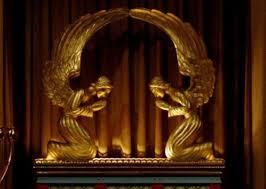The Furniture in God’s House
First Kings 7:13-51 and Second Chronicles 4:1 to 5:1

The writer takes the opportunity to underline the connection between the Tabernacle and the Temple. Since Solomon’s Temple is larger and more lavishly equipped than the Tabernacle, it was clearly not a mere imitation in a more permanent form. However, separate basic information is given on Hiram (to see link click Bd – Hiram, a Master Craftsman), the Bronze Pillars (see Be – Two Bronze Pillars), the Bronze Sea (see Bf – The Bronze Sea), ten Bronze Mobile Stands (see Bg – Ten Bronze Mobile Stands), as well as items not described elsewhere (see Bh – The Summary of Hiram’s Work), and lists given from different sources of the gold-work (see Bi – The Gold Furniture in the Temple).
There are also three principles emphasized in this section. First, the Temple’s structure and furniture signify the various ways that it means to be in the presence of YHVH. The need to be washed, the symbolism of the lampstands and the bread, the doors of the Most Holy Place, and even things like sprinkling bowls and censers, speak of God’s grace drawing near to us as well as His glorious holiness.
Second, the emphasis on the Temple furniture, as well as the association between the Tabernacle and the Temple, underlines the continuity represented by the Temple itself. The return of the Temple furniture to the Second Temple was one of the chief signs that post-exilic Isra’el remained a worshiping community of covenant people (see the commentary on Ezra-Nehemiah Bm – Ezra Reads the Scroll of Deuteronomy). The ongoing significance of the furniture is underlined by the reference of various kings restoring and repairing it for use in worship (Second Chronicles 13:11. 23:18-19, 29:18-19, and 33:1-16).
Third, the detail shows that Solomon was careful to follow the written instructions of ADONAI, with almost every item listed in First Chronicles 28:11-29 repeated here (see a video of Solomon’s Temple click here). The pattern of Moshe’s obedience in constructing the Tabernacle (Exodus Chapters 25-31 and 35-40) is therefore continued, in both cases culminating in God’s house being filled with His Sh’khinah glory (First Kings 8:11; Second Chronicles 5:13-14; Exodus 40:34-38).
The Temple’s interior also helps us understand what it means to worship ADONAI in His heavenly Sanctuary. Although the way was not fully revealed during the Dispensation of Torah (see the commentary on Exodus Da – The Dispensation of the Torah), as a result of Yeshua’s death, the way to heaven is now available to Gentiles as well as Jews. Its earthy point of entry is the cross outside the camp (Hebrews 13:11-14). There, Messiah died for sins once and for all (John 19:30), rendering any further earthly Temple and bronze altar moot (Hebrews 8:13). This Most Holy Place in heaven is to be a place of continuing worship as well as completed atonement. Here every believer may enter as a priest (First Peter 2:5-9), confident of never being turned away from the presence of Yeshua, the Bread of Life (see the commentary on The Life of Christ Fr – Jesus the Bread of Life) and the Light of the World (see The Life of Christ Gr – I Am the Light of the World). Believers are therefore encouraged to draw near to God with a sincere heart in full assurance of faith (Heb 10:22).132



Leave A Comment